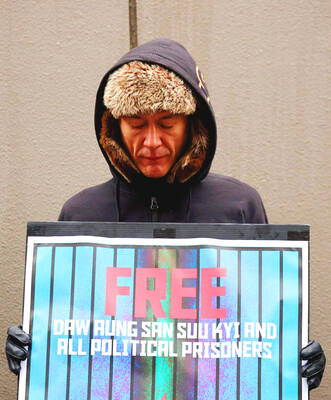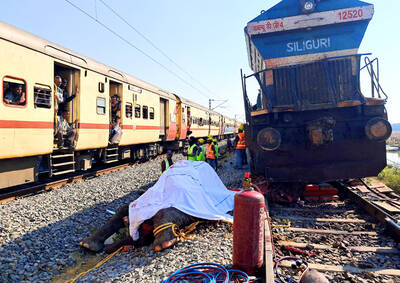To many he is the greatest scientist who ever lived, but a unique collection of Albert Einstein's letters and papers has revealed a history of struggle and failure made worse by an apparently shaky grasp of math.
An archive which goes on sale in London next month with a price tag of US$1.5 million shows how after transforming physics and securing unprecedented celebrity status with his general theory of relativity in 1916, Einstein suffered years of frustration as he failed to top that with "a grand theory of everything."
The 15 manuscripts and 33 letters penned between 1933 and 1954 give a glimpse into a period in Einstein's life when he strayed away from mainstream physics and grappled with the most fundamental questions concerning the universe.
"At the time, a lot of his colleagues, the theoretical physicists, felt that he was completely off the beaten path and so they didn't really take him seriously," said Howard Rootenberg, of Rootenberg Books in California, who is handling the sale. Although manuscripts dealing with Einstein's earlier work and his social and political views are relatively common, the collection is unique in helping to document the latter half of his life, when he moved to Princeton University in New Jersey and embarked on a struggle to unite all branches of physics.
Little impact
But his work in this period made very little impact on contemporaries and he never found his grand theory -- something physicists are still grappling with.
The archive was collected by Einstein's colleague Ernst Gabor Straus, a young mathematician whom the great physicist selected to help him during his Princeton years.
"A lot of people think of Einstein as a mathematical genius -- he wasn't," said David McMullan, a physicist at Plymouth University.
He said Einstein used Straus as he had used other mathematically gifted colleagues in his early career.
"Straus's mathematical virtuosity gave a framework to Einstein's intuitive vision of the universe," McMullan said.
He said it was fascinating to see breakthroughs not coming easily to Einstein.
"I do think it is interesting, the way you see him groping around. He's just trying anything. Here we see the greatest scientist who ever lived struggling and being honest about it," he said.
In one sequence of 16 letters Straus criticizes a line of inquiry that Einstein is pursuing and eventually persuades him to abandon it.
"It would take somebody with real balls to say to Einstein, `look, this is wrong,'" said Peter Coles, a physicist at Nottingham University.
The papers have never been studied because they have been held by Straus and his family since they were written. Einstein scholars were not even aware they existed until Straus's wife and son decided to put them on the market.
Grand theory
They tell the story of the two men's evolving thought process in the vain search for the unified field theory, as the grand theory was called.
Einstein hoped to unite the forces of gravity and electromagnetism under one theoretical framework, which would at the same time incorporate quantum mechanics. But the search turned out to be a series of blind alleys.

The Burmese junta has said that detained former leader Aung San Suu Kyi is “in good health,” a day after her son said he has received little information about the 80-year-old’s condition and fears she could die without him knowing. In an interview in Tokyo earlier this week, Kim Aris said he had not heard from his mother in years and believes she is being held incommunicado in the capital, Naypyidaw. Aung San Suu Kyi, a Nobel Peace Prize laureate, was detained after a 2021 military coup that ousted her elected civilian government and sparked a civil war. She is serving a

‘NO AMNESTY’: Tens of thousands of people joined the rally against a bill that would slash the former president’s prison term; President Lula has said he would veto the bill Tens of thousands of Brazilians on Sunday demonstrated against a bill that advanced in Congress this week that would reduce the time former president Jair Bolsonaro spends behind bars following his sentence of more than 27 years for attempting a coup. Protests took place in the capital, Brasilia, and in other major cities across the nation, including Sao Paulo, Florianopolis, Salvador and Recife. On Copacabana’s boardwalk in Rio de Janeiro, crowds composed of left-wing voters chanted “No amnesty” and “Out with Hugo Motta,” a reference to the speaker of the lower house, which approved the bill on Wednesday last week. It is

Seven wild Asiatic elephants were killed and a calf was injured when a high-speed passenger train collided with a herd crossing the tracks in India’s northeastern state of Assam early yesterday, local authorities said. The train driver spotted the herd of about 100 elephants and used the emergency brakes, but the train still hit some of the animals, Indian Railways spokesman Kapinjal Kishore Sharma told reporters. Five train coaches and the engine derailed following the impact, but there were no human casualties, Sharma said. Veterinarians carried out autopsies on the dead elephants, which were to be buried later in the day. The accident site

‘EAST SHIELD’: State-run Belma said it would produce up to 6 million mines to lay along Poland’s 800km eastern border, and sell excess to nations bordering Russia and Belarus Poland has decided to start producing anti-personnel mines for the first time since the Cold War, and plans to deploy them along its eastern border and might export them to Ukraine, the deputy defense minister said. Joining a broader regional shift that has seen almost all European countries bordering Russia, with the exception of Norway, announce plans to quit the global treaty banning such weapons, Poland wants to use anti-personnel mines to beef up its borders with Belarus and Russia. “We are interested in large quantities as soon as possible,” Deputy Minister of National Defense Pawel Zalewski said. The mines would be part